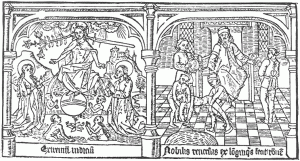I first happened upon a depiction of The Last Judgment by Giotto in the Scrovegni Chapel in Padua, Veneto, Italy. This artwork was completed about in about 1305. The scene is a typical judgment, with Christ in the center, the saved on his right, and the damned on his left. One commenter adds some interesting insight into his posture:
The seven virtues and seven vices are sometimes shown in opposition. In the Scrovegni chapel, the Last Judgement shows God with his right hand palm up towards the saved, and along the right wall are the seven virtues. His left hand is palm down towards the damned, and along the left wall are the seven vices, each opposite its corresponding virtue.2
Another commenter says:
Giotto has filled the entrance wall of the chapel with a great scene of the Last Judgment. Christ’s left hand, palm down, condemns the damned to the horrors of Hell. His right hand, palm up, beckons the blessed to join him in heaven–and with them a hopeful Enrico Scrovegni.3
This same pattern seems to repeat itself in many such depictions of Christ. The later famous depiction of The Last Supper by Leonardo da Vinci is said to have imitated Giotto’s posture of Christ, except with the palms reversed:
Understanding this, Jesus is not only at the center of infinity and providing his body and blood to the people, but he is infinite and universal in his body position. Leonardo references here Giotto’s painting of The Last Judgment, in which Jesus extends his arms with one palm up and one palm down. In doing so, Leonardo affirms Christ’s role as the viewer’s means of salvation.4
It is interesting that Christ has his hand down in the direction of the betrayer Judas Iscariot.
Another commenter on the scene of Leonardo’s The Last Supper said:
A woodcut from the Middle Ages shows the same posture, with this commentary:The mystical symbolism is repeated again in the hands of Jesus, positioned left palm up and right palm down, gestures which in the Renaissance symbolism of the Christian Kabbalists represented the pillars of the kabbalistic tree of life, Mildness and Severity- and the sephirot Geburah and Chesed- justice and mercy. The balance between these sephirah is Tiphareth, symbolized by the Seal of Solomon. (In Freemasonry, the square and compass shares similar symbolism).5
From the right side of Jesus’ head comes the lily of mercy and from the left the sword of vengeance; his right hand, similarly, is held palm up for the saved and his left palm down for the damned.6
There are many more examples of Christ in this posture, including The Last Judgment by Hieronymus Bosch (ca. 1482).
The Last Judgment depicted by Maso di Banco in Santa Croce, Florence, depicts the same. Jane Long refers to this position thus:
An interesting variation in these examples is that some depict the right hand not only with palm up, but with the right arm upraised also. The Last Judgment by Michelangelo in the Sistine Chapel is a famous example. The Tympanum (West Portal) of The Last Judgment to the Church of Ste. Foy at Conques, France, also shows Christ with a raised right arm towards the saved, and a lowered left hand towards the damned. One particularly nice example of this variation is The Last Judgment by Master of the Bambino Vispo (ca. 1422).The seated figure of Christ floats above a rocky landscape in a mandorla and makes the customary judging gestures - right palm up to accept the saved, left palm down to reject the damned.7
This posture again appears in Hans Memling’s depiction of The Last Judgment (ca. 1467-1471).
It is also interesting that this posture is also found in other cultures and traditions, particularly in the mudra gestures of Buddhism.
So it would seem that in addition to the incense filled hand found in ancient Israel, the palm up/palm down symbolism does have a place in Christianity, especially in Christian art. The palm up seems to depict blessing, receiving, mildness, mercy, and salvation, while the palm down seems to depict damnation, severity, justice, judgment, rejection, condemnation, and sin. At least that is what the Christians in the Middle Ages and Renaissance might have believed.
Post from: Temple Study - Sustaining and Defending the LDS (Mormon) Temple
Palm up/Palm down in Middle Ages & Renaissance Christian Art
Notes:- Jane C. Long, “Salvation through Meditation: The Tomb Frescoes in the Holy Confessors Chapel at Santa Croce in Florence,” Gesta, Vol. 34, No. 1 (1995), pp. 79.
- Number Symbolism in the Middle Ages.
- http://www.usccb.org/ccc/retreatguide.shtml
- Lauren Harrington, “Cusanus, Leonardo and the Last Supper,” http://evergreen.loyola.edu/brnygren/www/honors/ldv.htm
- Leonardo da Vinci - The Last Supper. http://altreligion.about.com/library/davinci/bl_lastsupper.htm
- Wilson, Adrian, and Joyce Lancaster Wilson. A Medieval Mirror. Berkeley: University of California Press, c1984 1984. http://ark.cdlib.org/ark:/13030/ft7v19p1w6/
- Jane C. Long, “Salvation through Meditation: The Tomb Frescoes in the Holy Confessors Chapel at Santa Croce in Florence,” Gesta, Vol. 34, No. 1 (1995), pp. 79.
Related Posts
Continue reading at the original source →







